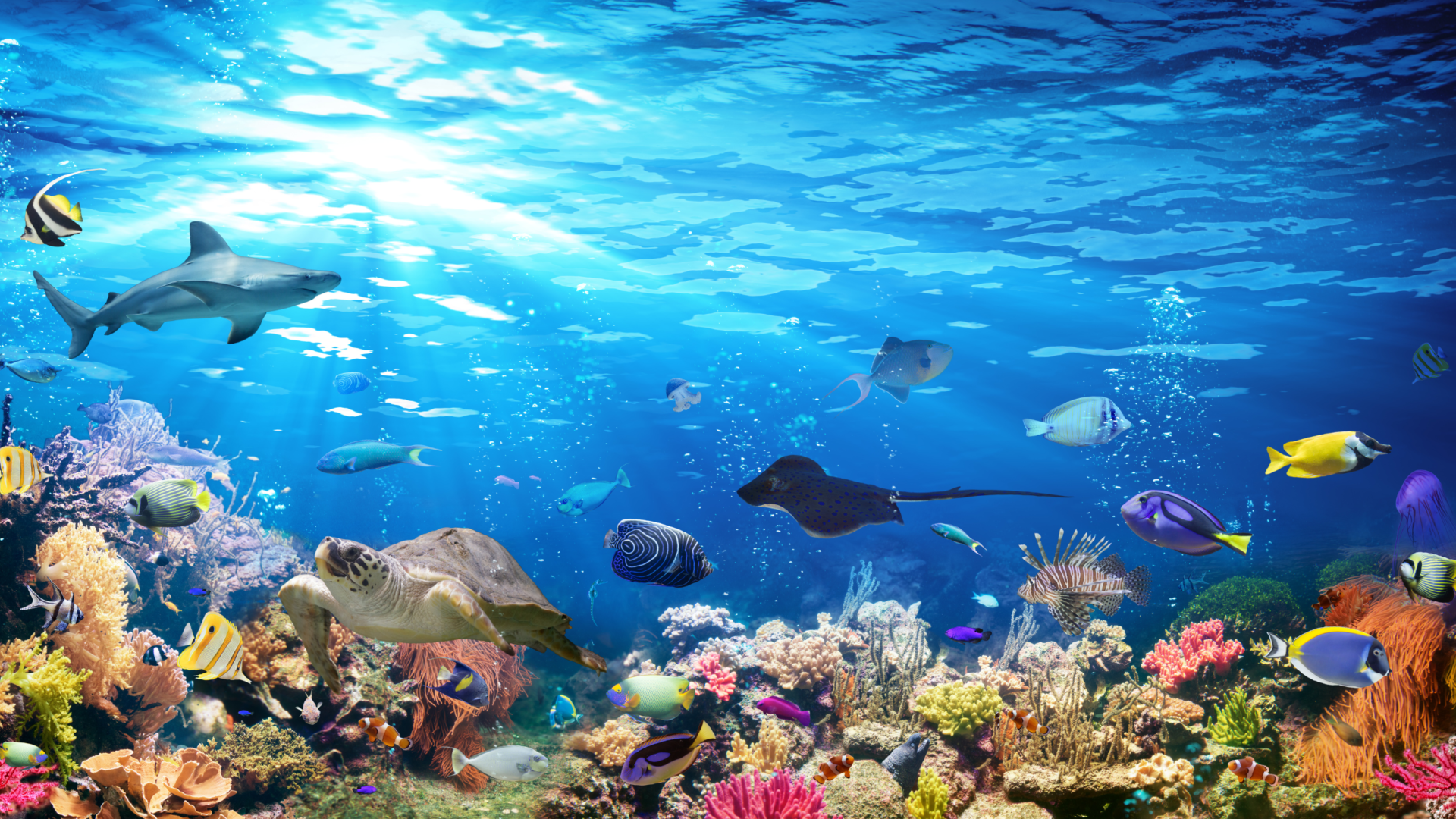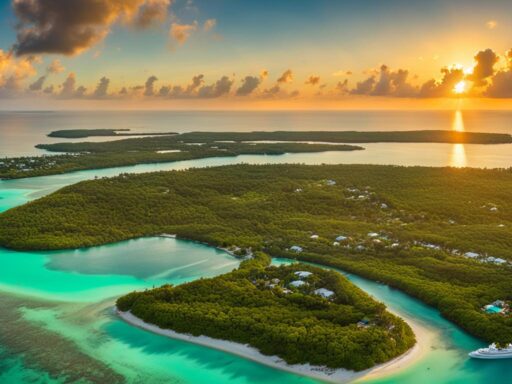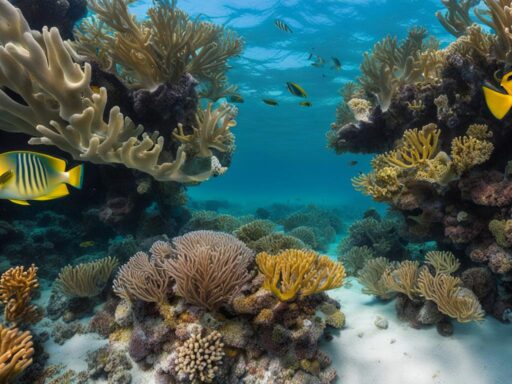The Florida Keys National Marine Sanctuary is a protected marine wilderness surrounding the Florida Keys, spanning 3,800 square miles. With its diverse ecosystems and incredible marine biodiversity, it is a haven for nature enthusiasts and explorers. Established in 1990, this sanctuary is jointly managed by NOAA and the State of Florida, ensuring the preservation of this natural treasure for generations to come.
Table of Contents
Key Takeaways:
- The Florida Keys National Marine Sanctuary is an expansive marine wilderness encompassing the Florida Keys.
- It is home to North America’s only coral barrier reef and a rich variety of marine life.
- Established in 1990, it is jointly managed by NOAA and the State of Florida.
- The sanctuary is dedicated to preserving the unique ecosystems and promoting conservation efforts.
- Visitors can enjoy a range of recreational activities, educational experiences, and witness the beauty of this underwater wonderland.
Protecting a Unique Ecosystem

The Florida Keys National Marine Sanctuary is dedicated to the preservation and protection of a unique and fragile ecosystem. The sanctuary faces various challenges, both natural and human-caused, that threaten the health of its coral reef and marine biodiversity. To combat these threats, conservation efforts and ecosystem protection initiatives have been implemented.
One of the primary goals of the Florida Keys National Marine Sanctuary is coral reef preservation. With North America’s only living coral barrier reef within its boundaries, the sanctuary plays a crucial role in safeguarding this fragile ecosystem. The reef is not only a breathtaking natural wonder but also a vital habitat for thousands of species of marine life.
“The coral reef is a precious resource that supports a vast array of marine biodiversity. It is imperative that we take proactive measures to ensure its long-term survival,” says Dr. Sarah Johnson, marine biologist and conservationist.
Conservation efforts in the sanctuary focus on reducing pollution, minimizing the impact of boating and fishing activities, and raising awareness about the importance of sustainable practices. By working collaboratively with stakeholders, including local communities, businesses, and visitors, the sanctuary aims to create a harmonious balance between human activities and ecosystem protection.
The Florida Keys National Marine Sanctuary serves as a testament to the significance of preserving our natural environment. Through ongoing conservation efforts and a commitment to ecosystem protection, this unique marine sanctuary will continue to thrive, ensuring a sustainable future for generations to come.
Unforgettable Marine Life Encounters
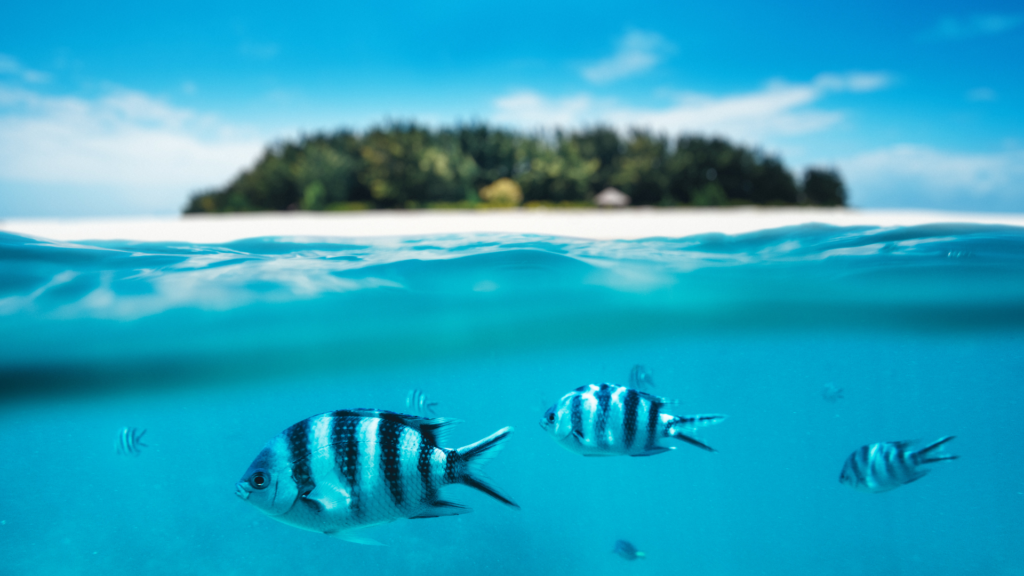
The Florida Keys National Marine Sanctuary is a haven for marine life preservation and offers visitors the opportunity for unforgettable encounters with a diverse array of underwater habitats. The sanctuary’s extensive coral reef system provides a vibrant and complex habitat for a wide range of marine species, making it a must-visit destination for nature enthusiasts and underwater explorers.
One of the highlights of the sanctuary is its colorful fish population, which includes species like angelfish, parrotfish, and butterflyfish. Snorkelers and scuba divers can witness these stunning fish gliding through the crystal-clear waters, adding a splash of vibrant color to the underwater world. The sanctuary is also home to sea turtles, dolphins, and the gentle manatees, creating opportunities for incredible encounters with these majestic creatures.
The preservation of these underwater habitats and the protection of marine life are at the core of the sanctuary’s mission. Through ongoing conservation efforts, the sanctuary aims to ensure the long-term survival of these species and promote sustainable practices that can help preserve the delicate balance of the marine ecosystem. Visitors can witness firsthand the importance of marine life preservation and learn about the sanctuary’s initiatives to protect these habitats for future generations.
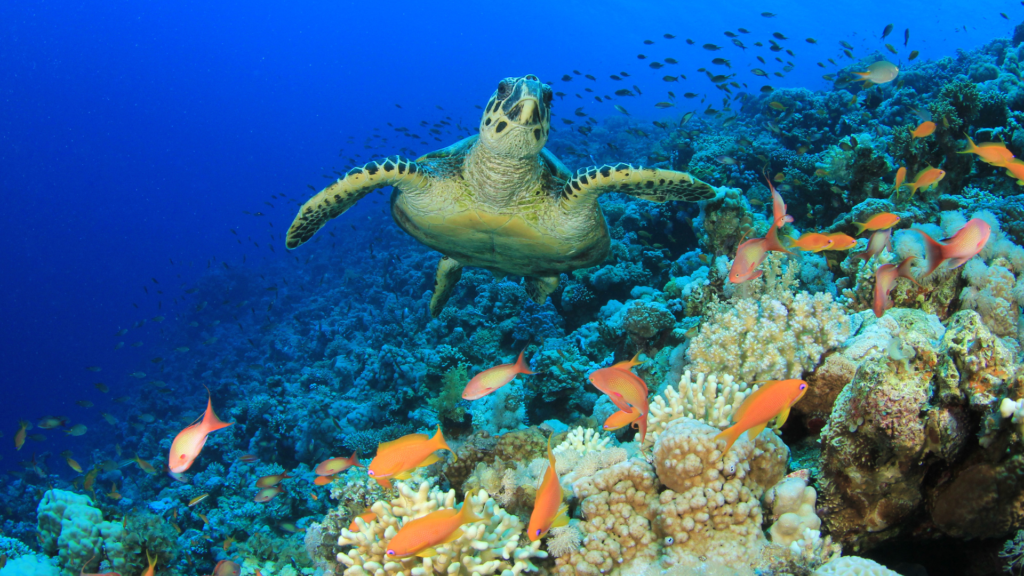
| Marine Species | Key Features |
|---|---|
| Colorful Fish | Angelfish, parrotfish, butterflyfish |
| Sea Turtles | Loggerhead, green, hawksbill |
| Dolphins | Bottlenose, Atlantic spotted |
| Manatees | Gentle giants of the sea |
Exploring the underwater world of the Florida Keys National Marine Sanctuary is a truly awe-inspiring experience. Whether you choose to snorkel, scuba dive, or simply observe from a glass-bottom boat, you’ll be surrounded by the beauty and wonder of the marine ecosystem. Through responsible tourism and a commitment to marine life preservation, we can ensure that future generations can continue to enjoy these remarkable encounters for years to come.
Recreational Activities for Everyone
When it comes to recreational activities, the Florida Keys National Marine Sanctuary offers something for everyone. Whether you’re an avid snorkeler, a seasoned scuba diver, a fishing enthusiast, or simply enjoy boating, the sanctuary has it all. With its diverse marine ecosystem, pristine coral reefs, and crystal-clear turquoise waters, it’s no wonder that visitors flock to this area in search of unforgettable experiences.
Snorkeling and Scuba Diving
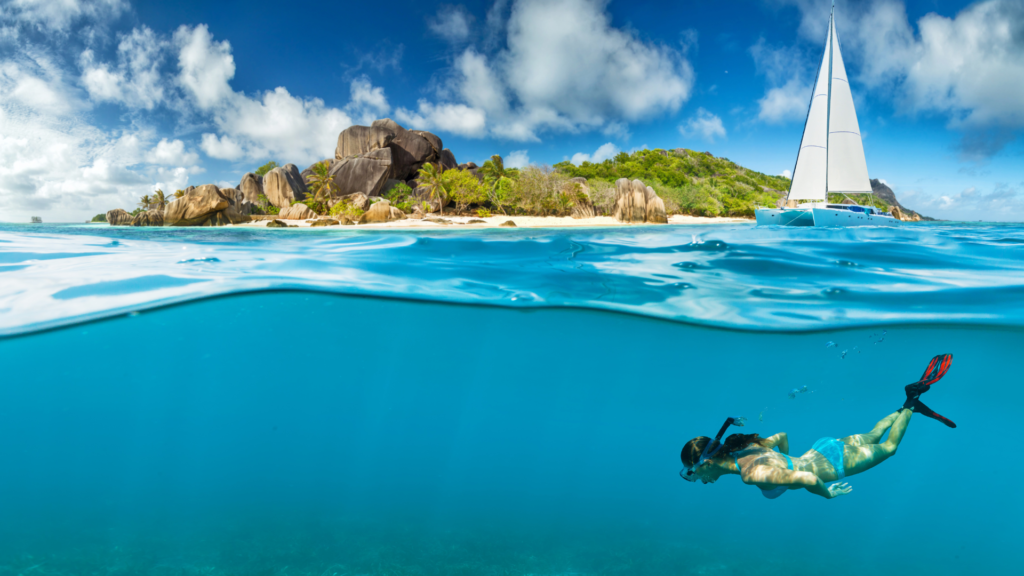
One of the most popular activities in the sanctuary is snorkeling. With its shallow reefs and calm waters, it’s the perfect way to explore the vibrant underwater world. Snorkelers can marvel at the colorful coral formations, swim alongside tropical fish, and even spot sea turtles gliding gracefully through the water.
For those looking for a more immersive experience, scuba diving is a must. With numerous dive sites to choose from, divers can explore the depths of the coral reef system and encounter a wide variety of marine life. From vibrant coral gardens to hidden caves and shipwrecks, the underwater world of the sanctuary never ceases to amaze.
Fishing and Boating
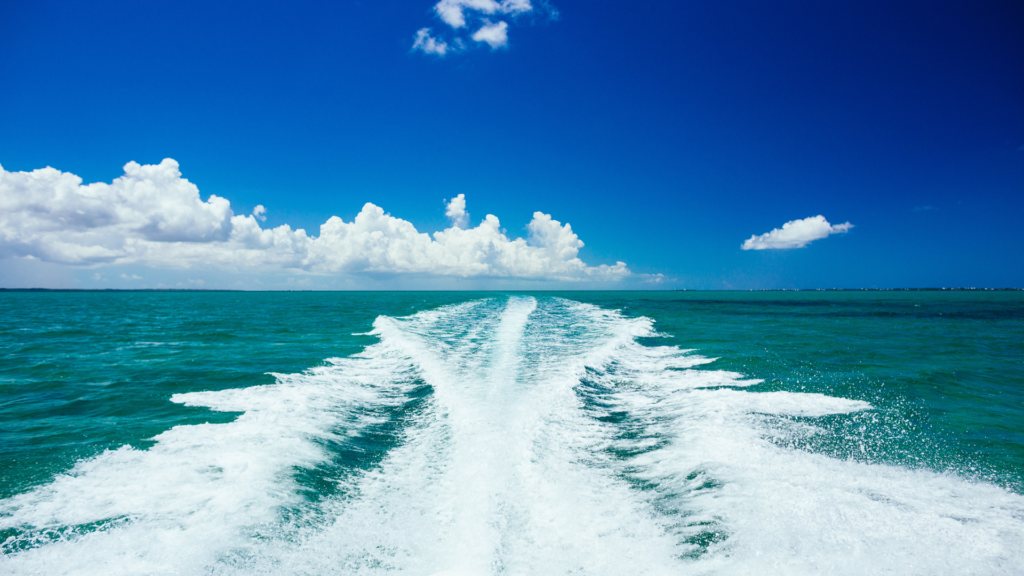
If fishing is your passion, the sanctuary offers abundant opportunities. Cast your line and try your luck in the rich fishing grounds, where you might reel in a variety of species including snapper, grouper, and tarpon. The scenic beauty of the area also makes boating a popular activity. Whether you prefer a leisurely cruise or an adrenaline-filled adventure, exploring the sanctuary by boat allows you to access secluded spots and take in the breathtaking views.
| Recreational Activities | Highlights |
|---|---|
| Snorkeling | Marvel at colorful coral formations and encounter tropical fish and sea turtles. |
| Scuba Diving | Explore the depths of the coral reef system and discover hidden caves and shipwrecks. |
| Fishing | Try your luck in the abundant fishing grounds and reel in a variety of species. |
| Boating | Enjoy a leisurely cruise or an adventurous ride while taking in the scenic beauty of the sanctuary. |
Whether you’re seeking adventure, relaxation, or simply a connection with nature, the recreational activities offered at the Florida Keys National Marine Sanctuary are sure to fulfill your desires. Dive into the clear waters, explore the coral reefs, and create lasting memories in this captivating marine wonderland.
The Beauty of Florida Keys National Marine Sanctuary
The Florida Keys National Marine Sanctuary is a stunning natural wonder, known for its marine biodiversity and pristine coral reefs. Located in the surrounding area of the Florida Keys, this sanctuary encompasses 3,800 square miles of protected marine wilderness. With its clear turquoise waters and vibrant coral formations, it offers a breathtaking underwater landscape that captivates visitors from around the world.
The sanctuary’s marine biodiversity is truly remarkable, with over 6,000 species of marine life calling it home. The coral reef system provides a habitat for an abundance of colorful fish, sea turtles, dolphins, and manatees. Witnessing the incredible variety of marine species in their natural habitats is an unforgettable experience that highlights the importance of preserving this unique ecosystem.
The pristine coral reefs of the Florida Keys National Marine Sanctuary are a sight to behold. These delicate ecosystems are home to a complex array of coral formations, providing shelter and sustenance for countless marine organisms. The vibrant colors and intricate structures of the coral reef system create a visually stunning environment that attracts divers and snorkelers seeking to explore its beauty.
Preserving the Beauty
Preservation efforts in the Florida Keys National Marine Sanctuary are vital to maintaining the beauty and biodiversity of this remarkable ecosystem. Through collaborative initiatives and sustainable practices, conservationists work tirelessly to protect the delicate balance of the coral reef ecosystem. These efforts ensure that future generations can continue to appreciate and enjoy the splendor of the sanctuary.
| Preservation Efforts: | Impact: |
|---|---|
| Marine Protected Areas | Provide safe zones for marine life to thrive and reproduce. |
| Sustainable Fishing Practices | Ensure the long-term viability of fish populations and maintain the ecological balance. |
| Coral Restoration Projects | Promote the recovery of damaged coral reefs and enhance their resilience to future threats. |
| Environmental Education | Raise awareness about the importance of marine conservation and foster a sense of stewardship. |
“The Florida Keys National Marine Sanctuary is a true gem. The breathtaking beauty of the coral reefs and the abundance of marine life make it a must-visit destination for anyone who loves nature. It’s a place where you can truly connect with the wonders of the underwater world.” – Visitor Review
Exploring the Florida Keys National Marine Sanctuary not only allows visitors to witness its natural beauty, but also raises awareness about the importance of marine conservation. By experiencing the sanctuary firsthand, people develop a deeper understanding of the fragility and resilience of the marine ecosystem, inspiring them to become ambassadors for its protection.
For those seeking to immerse themselves in the beauty of nature and discover the wonders of the underwater world, the Florida Keys National Marine Sanctuary is an unparalleled destination. With its marine biodiversity and pristine coral reefs, it offers a magical experience that fosters a deep appreciation for the marvels of our natural world.
Educational Experiences at the Eco Discovery Center
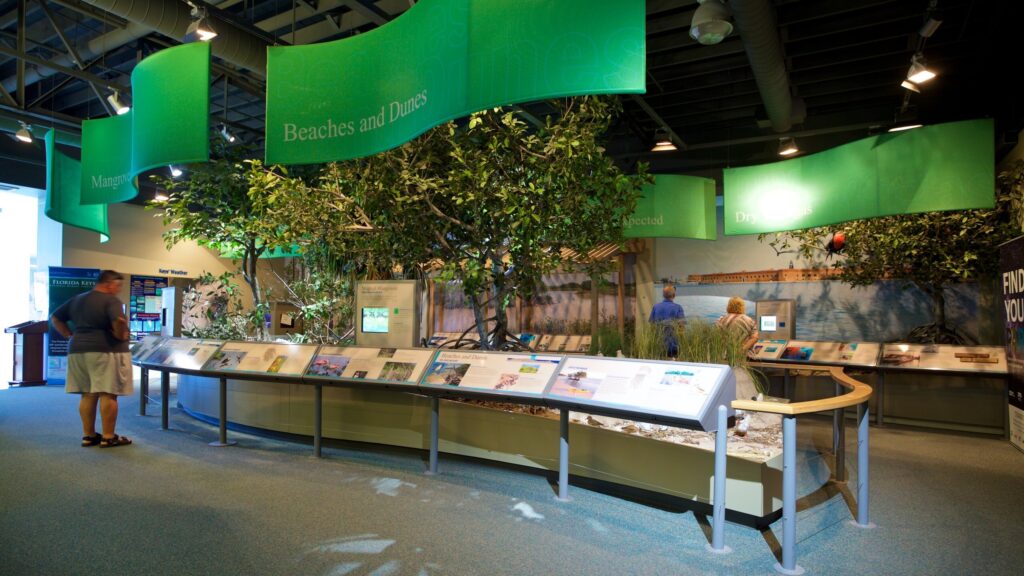
The Eco Discovery Center at the Florida Keys National Marine Sanctuary offers visitors a unique opportunity to deepen their understanding of the marine ecosystem and the conservation efforts in place. Through interactive exhibits, educational films, and knowledgeable staff, the center provides an engaging and informative experience for both children and adults.
Interactive Exhibits
The center’s interactive exhibits allow visitors to explore the wonders of the Florida Keys National Marine Sanctuary in a hands-on and immersive way. From simulated dives to virtual reality experiences, guests can learn about the diverse marine life, the delicate balance of the coral reef ecosystem, and the ongoing efforts to protect and preserve this remarkable environment.
Educational Films
The Eco Discovery Center features a theater where educational films are screened, offering insights into the marine biodiversity of the sanctuary and the challenges it faces. These films provide a comprehensive overview of the marine ecosystem and highlight the importance of conservation efforts in ensuring its long-term sustainability.
Knowledgeable Staff
The center’s staff are passionate and well-versed in the marine environment of the Florida Keys National Marine Sanctuary. They are available to answer questions, provide additional information, and offer guidance on how visitors can contribute to the preservation of this unique ecosystem. Whether it’s explaining the intricate interplay of species or discussing ongoing research and conservation initiatives, the staff are dedicated to enhancing the educational experience for all visitors.
Visiting the Eco Discovery Center is a must for anyone interested in learning more about the Florida Keys National Marine Sanctuary. It is a valuable resource that provides a deeper understanding of the marine ecosystem and the critical need for conservation efforts. Through interactive exhibits, educational films, and knowledgeable staff, visitors can gain a newfound appreciation for the remarkable beauty and fragility of this underwater world.
Historical Significance and Conservation Efforts

The Florida Keys National Marine Sanctuary not only protects the natural beauty of its marine environment but also holds significant historical treasures. The sanctuary safeguards historic shipwrecks and other archaeological sites, providing valuable insights into the area’s maritime past. Conservation efforts are in place to preserve these cultural resources for future generations to appreciate and learn from.
“The shipwrecks within the Florida Keys National Marine Sanctuary are like time capsules, offering a glimpse into the history of seafaring and maritime trade in this region,” says Dr. Rebecca Turner, a marine archaeologist. “These wrecks have incredible historical value and are important cultural resources that contribute to our understanding of the area’s past.”
The preservation of these shipwrecks requires ongoing conservation efforts. Specialized techniques are employed to protect the fragile structures from deterioration caused by factors such as waves, corrosion, and marine life. By carefully managing and monitoring these sites, the sanctuary ensures that these archeological treasures remain intact and accessible for scientific research and educational purposes.
Visitors to the Florida Keys National Marine Sanctuary can embark on guided tours to explore the historic shipwrecks. These tours provide an opportunity to learn about the stories behind these sunken vessels and the events that led to their demise. By experiencing the sanctuary’s historical significance up close, visitors gain a greater appreciation of the rich maritime heritage of the Florida Keys and the importance of preserving it.
Historic Shipwrecks in Florida Keys National Marine Sanctuary
| Ship Name | Date of Wreckage | Location |
|---|---|---|
| San Pedro | 1733 | Sombrero Key |
| USS Vandenberg | 2009 | Key West |
| Winfield Scott | 1850 | Carysfort Reef |
These are just a few examples of the fascinating shipwrecks that can be found within the sanctuary, each with its own unique story and historical significance. Through conservation efforts and responsible tourism, the Florida Keys National Marine Sanctuary ensures that these archeological treasures are protected and celebrated for generations to come.
Historical Roots and Creation Process of Florida Keys National Marine Sanctuary
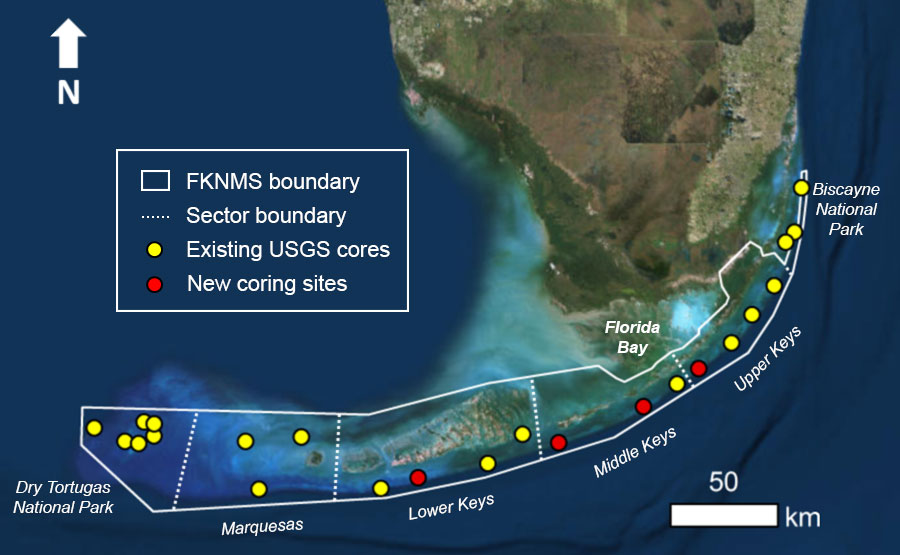
The Florida Keys National Marine Sanctuary, a protected marine wilderness spanning 3,800 square miles, has a rich history and a unique creation process. Its establishment can be traced back to early conservation efforts and the recognition of the deteriorating condition of the marine ecosystem in the Florida Keys.
In response to these concerns, the Florida Keys National Marine Sanctuary was officially designated in 1990 through the efforts of Congress and President George H. Bush. This designation marked the culmination of years of research, advocacy, and collaboration between various stakeholders, including scientists, government agencies, and local communities.
The creation process involved extensive consultations and negotiations to ensure the effective management and protection of the marine resources in the area. Through this partnership between the National Oceanic and Atmospheric Administration (NOAA) and the State of Florida, the sanctuary became the ninth addition to the National Marine Sanctuary System.
| Key Points | Details |
|---|---|
| Historical Roots | Early conservation efforts and recognition of deteriorating marine ecosystem. |
| Creation Process | Official designation in 1990 by Congress and President George H. Bush |
| Partnership | Joint management by NOAA and the State of Florida |
“The establishment of the Florida Keys National Marine Sanctuary is a testament to our commitment to marine protection and conservation. It showcases the power of collaboration and serves as a model for other marine sanctuaries around the world.” – NOAA Administrator
The creation of the Florida Keys National Marine Sanctuary reflects the collective understanding of the need to protect and preserve the fragile marine environment. It stands as a symbol of our responsibility to future generations, ensuring that the unique ecosystems and diverse marine life in the Florida Keys can be enjoyed for years to come.
Preserving a Marine Treasure
The Florida Keys National Marine Sanctuary is a testament to the ongoing efforts to safeguard our marine resources. By combining scientific research, conservation initiatives, and sustainable management practices, the sanctuary serves as a vital stronghold for marine protection and preservation.
- Protection of coral reefs and seagrass beds
- Conservation of marine biodiversity and endangered species
- Monitoring and mitigation of human-caused stressors on the ecosystem
In recognition of its importance, the Florida Keys National Marine Sanctuary continues to inspire and educate visitors from around the world. Whether through recreational activities, educational experiences, or simply immersing oneself in the beauty of the sanctuary, this marine treasure offers a unique opportunity to connect with nature and deepen our understanding of the marine world.
FAQ
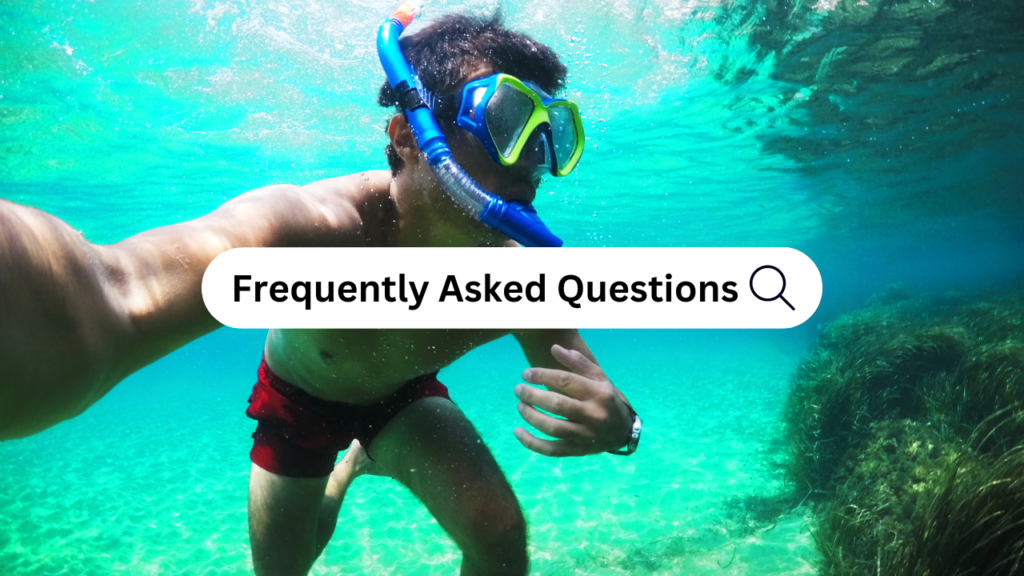
Q: What is the Florida Keys National Marine Sanctuary?
A: The Florida Keys National Marine Sanctuary is a protected marine wilderness spanning 3,800 square miles surrounding the Florida Keys. It is home to North America’s only coral barrier reef, extensive seagrass beds, mangrove-fringed islands, and over 6,000 species of marine life. Established in 1990, it is administered by NOAA and jointly managed with the State of Florida.
Q: What challenges does the Florida Keys National Marine Sanctuary face?
A: The sanctuary faces increasing challenges from natural and human-caused stressors. Collaborative efforts are necessary to address these challenges and ensure the long-term preservation of this unique ecosystem.
Q: What recreational activities can I enjoy at the sanctuary?
A: The sanctuary offers a host of recreational activities including snorkeling, scuba diving, fishing, and boating.
Q: What can I expect to see underwater at the Florida Keys National Marine Sanctuary?
A: The sanctuary is teeming with diverse marine life, including colorful fish, sea turtles, dolphins, and manatees. The coral reef system provides a habitat for a wide range of marine species.
Q: What educational experiences are available at the Eco Discovery Center?
A: The Eco Discovery Center offers interactive exhibits, educational films, and knowledgeable staff to provide a deeper understanding of the marine ecosystem and the conservation efforts in place.
Q: What do visitors say about their experiences at the sanctuary?
A: Visitors have left highly positive reviews, praising the beauty of the area, the abundance of marine life, and the engaging experiences they had.
Q: What historical significance does the sanctuary hold?
A: The sanctuary protects historic shipwrecks and other archeological treasures, offering insights into the area’s rich maritime history.
Q: How was the Florida Keys National Marine Sanctuary created?
A: The sanctuary was officially designated in 1990 through the efforts of Congress and President George H. Bush. It joined the National Marine Sanctuary System as the ninth sanctuary.
Q: What can I expect to see during underwater exploration at the sanctuary?
A: Underwater exploration in the sanctuary reveals the intricate interplay of species and the delicate balance of the coral reef ecosystem.


